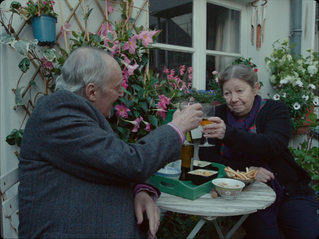The Unseen Scene: Buñuel’s Belle de Jour Box
- Caitlin Wilson
- Feb 7, 2022
- 3 min read
Updated: Feb 8, 2022
Luis Buñuel, 1967

The power of the unseen in cinema is paradoxical. For all that film can touch us, break us out in goosebumps, provoke us to tears or screams or laughter, we ingest it through our eyes first. It is a deeply ocular-centric medium. So what happens when we are denied this visual input, left instead to ponder at the possibilities of the hidden? Luis Buñuel’s famous box scene in Belle de Jour, with its legacy of discussion, confusion and delight, illustrates the grip of the unseen on audiences. The film centres on Séverine, a beautiful bourgeois woman beset by masochistic erotic fantasies, who begins working in a brothel. In this scene, a man comes to her seeking custom, bringing with him a small ornate box. The shot in question frames Séverine and the man on either side of the box, as she opens the lid away from the camera. The staging is highly presentational, save for the inside of the box. We see the man and Séverine in the centre of the frame, bodies turned toward the camera. They are highly available to our eyes, a rich tapestry for perception. Séverine’s white bra, the customer’s business attire, even the ornate exterior of the box - all give us data to mine, clues on the characters’ motives and inner lives.
Indeed, much of Buñuel’s film is a visual treat: Séverine’s Yves Saint Lauren outfits, its lavish Parisian locales. And yet, it’s the hidden object(?) inside the box that captures our fascination. A buzzing sound can be heard from within, high-pitched and insectile, but we are never treated to the surely shocking visual inside the container. This moment of unsatisfied suspense, so simply rendered in a static mid-close up, is deeply captivating precisely because, deprived of visual confirmation, our imagination is given room to meet the film in its perversion. Is the box merely a metaphor for the woman as an empty vessel, a yonic symbol of mystery? Is it filled with aphrodisiac insects, ready to bite Séverine and send her into a frenzy? Is the buzzing sound diegetic, or a red herring?
All of the film’s sex scenes are similarly unseen, perhaps extending our foray into fantasy and conjecture. What we are treated to instead is moments of aftermath - in this case, Séverine sprawled face down on the bed, the bottom half of her body covered with a white sheet. A worker in the brothel enters the room, finds a bright red spot of blood on a towel. A lamp on the table next to the bed is askew. These items provide clues, but the real mystery in this scene is Séverine’s face. When she lifts her head, her expression is inscrutable. The sides of her mouth gently slope up; the edges of a smile. Is she satisfied? In shock? Though we see her face, her mind, her true feelings, are unseen; enigmatic.
This all aligns with Buñuel’s devotion to the surreal. Buñuel is known to oppose ‘psychological’ interpretations of his films, preferring his audience to embrace the unknowns of the film experience rather than explain them away with Freudian dissection. Buñuel’s sly crediting of ‘the marvellous whores’ of Belle de Jour with the film’s success, rather than his own direction, points to an understanding of the primacy of looking, rather than analysing, within his oeuvre. The unseen heightens the seen, enticing the audience deeper into Belle de Jour’s visual pleasures, rather than away from them. Perhaps Belle de Jour’s box contains something more surreal than we can picture, perhaps it contains nothing. This unknowability is its true power – it brushes us up against the limits of our own imagination.







